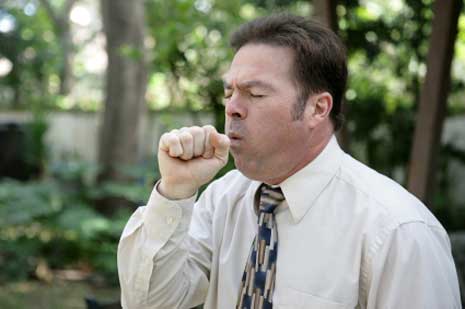Research reveals exactly how coughing is triggered by environmental irritants

Scientists have revealed how environmental irritants such as air pollution and cigarette smoke cause people to cough, in research published today in the American Journal of Respiratory and Critical Care Medicine. The authors of the study, from Imperial College London and the University of Hull, have identified the reaction inside the lungs that can trigger coughing when a person is exposed to particular irritants in the air. They suggest that their findings may ultimately lead to the development of new treatments for chronic coughing.
Coughing is the most common reason for people visiting a family doctor. Treatment options are limited for people with chronic coughing; a recent study concluded that over-the-counter remedies are ineffective and there is increasing concern about the safety of these therapies in children.
Today’s study indicates, for the first time, how coughing can be triggered when a person is exposed to certain irritants in the air. It shows that the irritants can switch on receptor proteins called TRPA1 on the surface of nerve endings in the lungs. This switches on sensory nerves, which then trigger a cough reflex. The researchers say coughing could potentially be treated by blocking TRPA1 receptors, to stop irritants in the air from setting off this chain reaction. They hope that this could ultimately help millions of people whose lives are affected by chronic coughing.
Professor Maria Belvisi, corresponding author of the study from the National Heart and Lung Institute at Imperial College London, said: “For some people, chronic coughing can be annoying and uncomfortable, but for others it can be distressing and can have a severe impact on their quality of life. Many people say that certain things in the air can make them cough and we are very excited that we have shown, for the first time, exactly what is probably happening inside the lungs. Now that we think we have cracked the mechanism, we can start investigating whether we can stop people from coughing excessively by blocking the receptor protein that triggers it.”
To reach their conclusions, the researchers first looked at sensory nerves from mice, guinea pigs and humans, and showed that the receptors on the sensory nerves were activated by a number of irritants, including a key compound in cigarette smoke (acrolein) and a chemical called cinnamaldehyde. The researchers then blocked the receptors and showed that these substances no longer activated the nerves.
To establish whether activating the receptor causes coughing, the researchers looked at the effect of acrolein on guinea pigs, as they have a coughing reflex. The researchers assessed the guinea pigs’ coughing after inhaling acrolein. The compound caused coughing, and the higher the concentration, the more the guinea pigs coughed. The researchers then showed that blocking the receptor using a drug significantly reduced the guinea pigs’ coughing response to the compound.
Finally, researchers led by Professor Alyn Morice at the University of Hull looked at the effect of inhaling the chemical cinnamaldehyde in humans. Ten healthy, non-smoking volunteers inhaled the chemical, as well as control substances. The researchers measured their cough response on five occasions, 2-3 days apart. All of the volunteers coughed after inhaling the compound.
Reference: Imperial College London, Research reveals exactly how coughing is triggered by environmental irritants, November 23, 2009



 The study described was initiated by the Israel Ministry of Health as an effort to respond to and deal with public concern about possible health disorders related to odorous emissions (composed of a great many of organic and inorganic chemicals) from the regional industrial park (IP) in the Negev, southern Israel. Previous ecological studies found that adverse health effects in the Negev Bedouin population were associated with residential proximity to the IP. The objective of the current study was to investigate a hypothesis concerning the link between the IP proximity and life prevalence (LP) of upper respiratory tract chronic diseases (URTCD) and asthma in children aged 0-14 years living in rural Negev, Israel, in small agricultural communities.
The study described was initiated by the Israel Ministry of Health as an effort to respond to and deal with public concern about possible health disorders related to odorous emissions (composed of a great many of organic and inorganic chemicals) from the regional industrial park (IP) in the Negev, southern Israel. Previous ecological studies found that adverse health effects in the Negev Bedouin population were associated with residential proximity to the IP. The objective of the current study was to investigate a hypothesis concerning the link between the IP proximity and life prevalence (LP) of upper respiratory tract chronic diseases (URTCD) and asthma in children aged 0-14 years living in rural Negev, Israel, in small agricultural communities. 